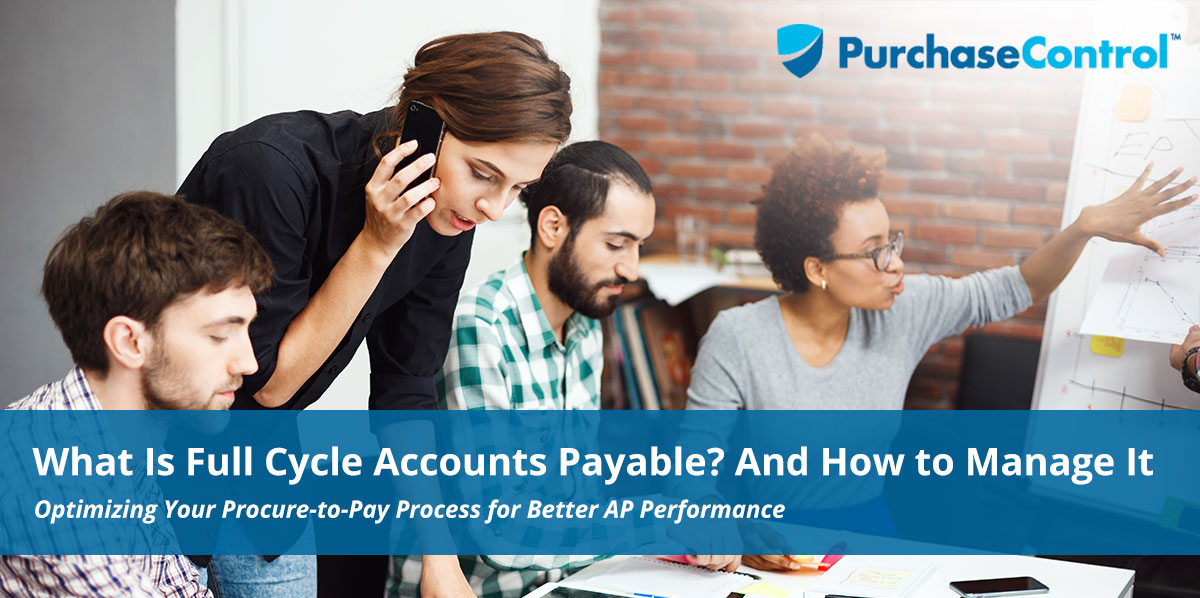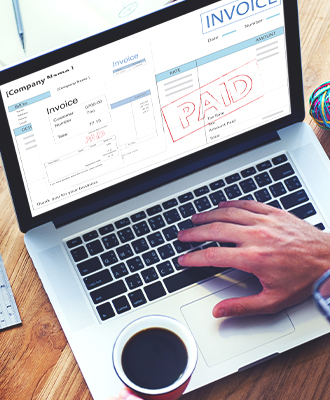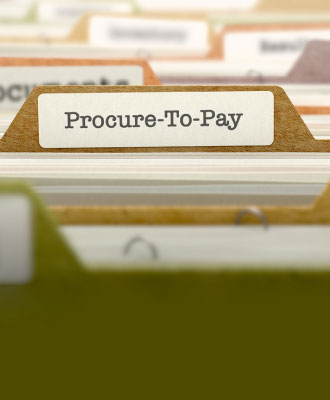Effective business process management is important to every workflow big and small. But some processes loom larger in the healthy operation and growth of a business than others. Managing crucial business workflows such as full cycle accounts payable effectively is essential to protecting value creation and return on investment (ROI) while lowering overall costs and improving productivity.
A core component of every purchase your company makes, full cycle accounts payable represents a significant opportunity to gain not just savings, but competitive advantage, improved supplier relationships, and greater productivity and efficiency. By understanding how it works and leveraging the right technology in conjunction with some basic best practices, you can transform your accounts payable function into a value-creation center for your business
Full Cycle Accounts Payable Defined
Also known as the procure-to-pay process, the term “full cycle accounts payable” refers to the entire bookkeeping process of completing a purchase, from the purchase order process to the final receiving, confirming, and disbursing funds for an invoice. Less commonly, the term is also applied to the position filled by an accounts payable clerk or accounts payable specialist responsible for performing those duties.
The process itself is defined by both three distinct stages—each with clearly documented and delineated workflows—and three important documents, each of which plays an important shared role in ensuring every purchase is cost effective, legitimate, and complete. Performed properly and efficiently, the processes help speed payment of vendor invoices while guarding against fraud and providing an easily-verified audit trail for financial statements, financial planning, etc.
Each stage is named for the document associated with it:
- The Purchase Order Stage covers the creation, approval, and submission of a purchase order by the purchasing department for goods and services to the appropriate vendor. When the vendor receives and accepts an approved purchase order from your company, they enter into a legal agreement with you to provide the requested goods and services at the price specified, under the terms and conditions listed in the PO.
- The Receiving Report Stage involves the creation of a receiving report, a complete record of everything received in the shipment from the vendor, once goods arrive. Receiving staff compare the shipping documents to the original purchase order. Exceptions (including missing, incorrect, improperly priced, or damaged items) are noted by staff in the report for follow-up with the vendor. Goods accepted are moved to inventory, and their quantities updated in the system.
- The Vendor Invoice Stage is triggered when the accounts payable department receives an invoice from the vendor for goods received or services rendered. At this stage in the process, accounts payable staff perform what is known as a three-way match to compare the purchase order, receiving report, and vendor invoice to confirm all three documents have the same information regarding pricing, terms, quantity and quality of goods ordered, etc.
Discrepancies (including those noted on the receiving report) are classified as exceptions. Each one requires time and effort to rectify, as an accounts payable team member has to track the discrepancies to the vendor, receiving department, or the original purchaser.
On the other hand, if all three documents match, then the invoice can be sent for final approval (or marked for payment, if it falls within certain pre-approved spending levels). For companies using double-entry bookkeeping (i.e., most companies) approved invoices are marked paid and recorded as journal entries in the appropriate sub ledger of the general ledger once AP issues a check or electronic payment to the vendor.
“The accounts payable process—in particular, the full cycle accounts payable process—has a significant and daily impact on the health and performance of your company, because it touches every dollar flowing out of your coffers in exchange for the goods and services you need to do business.”
The Crucial Importance of Accounts Payable
The accounts payable process—in particular, the full cycle accounts payable process—has a significant and daily impact on the health and performance of your company, because it touches every dollar flowing out of your coffers in exchange for the goods and services you need to do business.
The P2P process flows in two directions: upstream and downstream.
Upstream lies procurement, where tasks like supply chain management, vendor relationship development, strategic sourcing and contract management are used to set the stage for maximum return on investment by standardizing practices and codifying pricing, terms, and mutual obligations between buyers and suppliers. These processes can be fine-tuned to ensure every purchase made is visible, legitimate, and made with the best possible vendor, with the best possible payment terms, and the least risk exposure.
Downstream, accounts payable handles post-contractual workflows and the actual receipt, verification, and payment of vendor invoices in a timely manner. These processes represent an important opportunity to capture additional savings and value, both directly (early payment discounts) and indirectly (optimized workflows that eliminate human error, delays, and fraud that could lead to damaged relationships as well as late payments, fines, etc.).
Just like a river, maximizing water (data) quality and minimizing logjams (process inefficiencies) upstream in full cycle accounts payable can help ensure clear, clean, and fast-moving waters downstream in AP. Optimizing upstream processes makes it easier for accounts payable team members to implement the improvements to their own workflows that will secure additional value and savings for your business.
Maximizing AP Value Creation with Automation, Analytics, and AI
Every company will have its own unique interpretation of what constitutes best practices for accounts payable. That said, small businesses eager to compete effectively in a challenging and complex global marketplace will benefit from prioritizing three practices of growing import in the age of digital transformation: Automation, Artificial Intelligence (AI), and Analytics.
Investing in a cloud-based, comprehensive procurement solution like PurchaseControl is one of the most effective ways to apply those best practices to your entire P2P process.
Consider these benefits:
- A comprehensive solution makes it possible to create a closed purchasing system upstream; automatic integration with contract management, supplier relationship management, and financial analysis/planning modules secures and simplifies everything from contract creation to vendor onboarding to P2P.
- The same closed system automatically connects buyers with the right vendor for every purchase, automatically populating terms and conditions, pricing terms, and vendor information while still allowing for adjustments where needed. Rogue spend and invoice fraud are eliminated, along with the need for tedious, time-consuming data entry by staff.
- Total transactional transparency improves data quality across the board; cash flow is more accurate, as are financial statements, expense reports, etc. Audit trails are complete and readily available for internal and external audits.
- Real-time access to all financial data, as well as advanced analytics, make it possible for leadership to generate financial reports on demand.
- Full integration with existing enterprise resource planning (ERP) solutions, accounting software, marketing software, and office suite applications like Microsoft Excel or bookkeeping applications like QuickBooks make it easy to corral, manage, and analyze all your workflows and data. Purchasing data, along with supplier performance, vendor relationship, and other data sets can be analyzed to reveal new opportunities for innovation, further process improvements, or strategic partnerships with suppliers to obtain greater savings.
- AI-supported process automation, including automatic three-way matching, removes human error and needless delays. Every vendor invoice is automatically checked against receiving records and the original purchase order; exceptions are automatically flagged for review, matches are automatically routed for approval or payment. Your AP department wastes less time and money on data entry and chasing exceptions, and spends more time generating value with higher-level tasks.
- Process optimization is iterative via machine learning; continuous improvement becomes the standard for all processes, not just accounting activities, so every process becomes better at reducing costs and increasing value over time.
- Processing times (including the approvals process), and therefore per-unit costs, for purchase order and invoice processing are reduced dramatically across the entire payable cycle.
- Eliminating paper-based workflows and manual processes, along with the need for physical storage of paper media, reduces the company’s environmental footprint and associated costs.
- Vendor payments can be made electronically and, depending on the parameters you set, automatically. More early payment discounts are captured; late fees and fines are eliminated.
Optimize Your Full Cycle Accounts Payable Workflows
Whether you call it procure-to-pay, P2P, or full cycle accounts payable, ensuring it’s at its absolute best will give your business total transparency into spend, better cash flow management, and invaluable insights you can use for strategic financial planning and growth.
By investing in automation technology and applying AP best practices, you can be sure every purchase is processed as quickly, efficiently, and accurately as possible. You’ll capture more early payment discounts, avoid needless late fees and penalties, and build strong relationships with your vendors while ensuring you get the best possible price—and value!—for every dollar you spend.
Automate and Streamline Your AP Workflows for Maximum Value and Savings with PurchaseControl
Find Out How








